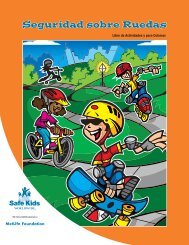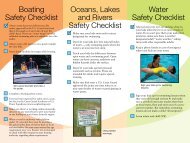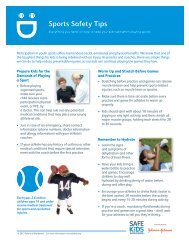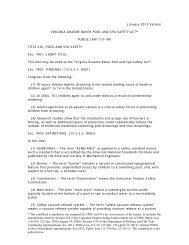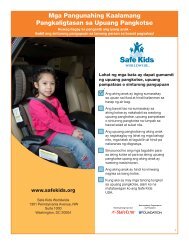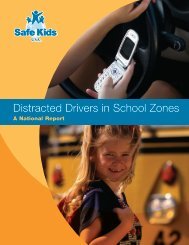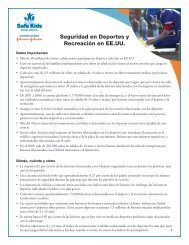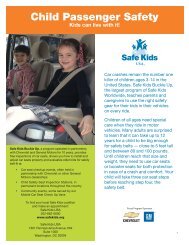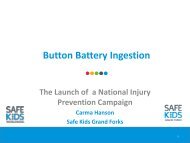Coaching Our Kids to Fewer Injuries Advocacy Guide - Safe Kids ...
Coaching Our Kids to Fewer Injuries Advocacy Guide - Safe Kids ...
Coaching Our Kids to Fewer Injuries Advocacy Guide - Safe Kids ...
You also want an ePaper? Increase the reach of your titles
YUMPU automatically turns print PDFs into web optimized ePapers that Google loves.
<strong>Coaching</strong> <strong>Our</strong> <strong>Kids</strong> <strong>to</strong> <strong>Fewer</strong> <strong>Injuries</strong><strong>Advocacy</strong> <strong>Guide</strong>: A Challenge for School BoardsIntroductionThis guide <strong>to</strong> advocacy for a sports safety prevention program at the school board level hastwo purposes. First, it is designed <strong>to</strong> give you a roadmap for a real time advocacy effort at thegrass roots level; second, it will provide you with some ideas <strong>to</strong> guide you in other advocacyefforts you undertake as a <strong>Safe</strong> <strong>Kids</strong> coalition or chapter. We are here <strong>to</strong> help you in any waywe can. This guide is part of our <strong>Safe</strong> <strong>Kids</strong> Week (April 21-28) focus on youth sports safety,the third year of an effort which is funded by our founding sponsor Johnson & Johnson.Sports: Fun, <strong>Safe</strong> and Essential“I once heard thatthe injury rate in theNFL is 100 percent.It looks <strong>to</strong> me, ingirls’ soccer, it’s thesame thing.”– David Cooper, fatherof Bethesda-Chevy ChaseHigh School soccer playerHannah Cooper, The NewYork TimesSchool sports are a fundamental part of growing up for many children, and we must bevigilant in preventing injury as much as possible, while keeping it fun and a growingexperience. Much progress has been made in providing education information aboutconcussions sustained in school sports. However, sports injury is not reserved <strong>to</strong> those whoplay football, or for boys for that matter, and public policy must move <strong>to</strong>wards attention <strong>to</strong>presenting sports injuries in a comprehensive way: the broader spectrum of injury and sports,and for both boys and girls.How Do We Get There?“All politics is local.” *<strong>Our</strong> approach is <strong>to</strong> effect real results in preventing sports injuries at the local level, throughadvocacy aimed at schools boards — men and women, many times parents, who give theirtime <strong>to</strong> making local schools the best they can be. We urge <strong>Safe</strong> <strong>Kids</strong> coalitions and chapters<strong>to</strong> join <strong>to</strong>gether in this campaign <strong>to</strong> urge school boards <strong>to</strong> adopt best practices <strong>to</strong> deal withall sporting injuries.Nine Steps <strong>to</strong> Success1. Set Your Goal. Every campaign must have a goal. Put simply, we are hoping thatschool boards around the nation will establish a program <strong>to</strong> ensure that all coaches aretrained in the common injuries that occur in their teams and more specifically have apro<strong>to</strong>col for dealing with injuries. A starting place may be the three-prong strategy adoptedby many states <strong>to</strong> prevent complications from concussions in sports. The model has beenthe Zackery Lystedt Law passed in Washing<strong>to</strong>n State in May 2009. The language of theWashing<strong>to</strong>n state law is here.• If a young athlete is suspected of having a concussion, he/she must be removed from agame or practice and not be permitted <strong>to</strong> return <strong>to</strong> play. When in doubt, sit them out.* Quote attributed <strong>to</strong> Thomas P. O'Neill, the late Speaker of the House of Representatives.
<strong>Safe</strong> <strong>Kids</strong>’ goalis <strong>to</strong> establisha program atthe local levelensuring that allcoachesare trained insports injuryprevention in thesports they coach.The lesson here is <strong>to</strong> have s<strong>to</strong>ries <strong>to</strong> tell about kids in your area who have been hurt by notfollowing best practices. It is effective <strong>to</strong> have parents or kids act as spokespeople, writeletters and op-ed articles, appear on electronic media, post on Facebook or even start a blog.4. Know Your Targets. Another kind of research that will be crucial is knowing aboutthe school board members you will be trying <strong>to</strong> convince.• What was their inspiration for running for the school board seat?• Were they child athletes, and what did they play?• Do they have kids who are in the school system or who graduated from it? Did theirkids play sports? Did they have any injuries?• What makes them tick? Are they sports fans?A Noteabout TonePlaying teamsports is fun, andwe don’t want <strong>to</strong>take the fun ou<strong>to</strong>f sports withthis campaign.<strong>Our</strong> intent is <strong>to</strong>emphasize thatsports can befun and safe.Involvement insports is also avital part of a kid’stime in school.Let’s make thiscampaign apartnership forsafety. The time <strong>to</strong>act is now.5. Build Your Network. There are always common interests with other organizations in acampaign <strong>to</strong> affect change, and on sports safety, some of your allies include the following:• Children’s Hospitals.• Universities with physical education degrees.• Athletic trainers.• Sports medicine physicians and their organizations• Parent-teacher organizations.• School nurses.• Active or retired coaches.What could really make a campaignlike this go viral would be a celebrity,e.g. a respected football player, as aspokesperson. The National FootballLeague has a significant program <strong>to</strong>cope with sports-related concussioninjuries. As of April 2012, at least 21of the 31 states passed concussion lawswith the support of the NFL or a proteamincluding California, Colorado,Texas, New Mexico, Maryland,Louisiana, Alabama and Missouri.In some states and <strong>to</strong>wns, collegesports is the thing, and a star athletecan be an effective spokesperson.Also, check <strong>to</strong> see if any recent U.S.Olympic competi<strong>to</strong>rs live nearby.What’s a concussion?According <strong>to</strong> the Centers for Disease Controland Prevention, a concussion is a type oftraumatic brain injury (TBI), caused by a bump,blow, or jolt <strong>to</strong> the head that can change theway your brain normally works. Concussionscan also occur from a fall or a blow <strong>to</strong> the bodythat causes the head and brain <strong>to</strong> move quicklyback and forth. Even a “ding,” “getting yourbell rung,“ or what seems <strong>to</strong> be a mild bumpor blow <strong>to</strong> the head can be serious. You can’tsee a concussion but signs and symp<strong>to</strong>ms ofconcussion can show up right after the injury ormay not appear or be noticed until days or weeksafter the injury. 1But remember: concussions are not the onlyinjuries sustained in sports.1 Centers for Disease Control and Prevention, Injury Prevention& Control. Concussion and Mild TBI. Available from: http://www.cdc.gov/concussion/ Accessed April 17, 2012.- 3 -
<strong>Kids</strong>’ Sports by the Numbers*• More than 38 million children and adolescents participate in sports each year in the United States.Nearlythree-Quarters of United States households with school-age children have at least one child who playsorganized sports.• Each year, more than 3.5 million children ages 14 years and under receive medical treatment for sportsinjuries.• Approximately two-thirds of all sports-related injuries leading <strong>to</strong> emergency department visits are forchildren. The rate and severity of sports-related injury increases with a child’s age.• From 2001 through 2009, it is estimated that there are 1,770,000 emergency department visits, 6%of these for traumatic brain injuries, among children ages 14 and under for injuries related <strong>to</strong> sports orrecreation.• Though rare, traumatic brain injury is the leading cause of sports-related death.• Approximately one out of five traumatic brain injuries among children are associated with participation insports and recreational activities.• More than 90 percent of sports-related concussions occur without the loss of consciousness.• Most organized sports-related injuries – 62 percent – occur during practice rather than games.These statistics tell part of the s<strong>to</strong>ry on why we need a broad-based program on sports injury prevent. Therest of the s<strong>to</strong>ry is <strong>to</strong>ld in testimony by parents, children and coaches on the pain and tragedies they haveencountered.Sample Quote – Use a local quote.“I once heard that the injury rate in the NFL is 100 percent. It looks <strong>to</strong> me, ingirls’ soccer, it’s the same thing.”— David Cooper, father of Bethesda-Chevy Chase High School soccer playerHannah Cooper, The New York Times* Source: Sports and Recreation <strong>Safe</strong>ty Fact Sheet. Washing<strong>to</strong>n, DC: <strong>Safe</strong> <strong>Kids</strong> Worldwide, 2012.- 6 -
Sample Letter Requesting a Meeting with a School Board Member(Yellow highlights are signals for your inserts)Dear Ms. Boardley:I congratulate you on your public service as a member of the (name of municipality) School Board and yourcommitment <strong>to</strong> the schoolchildren. As a leader in the <strong>Safe</strong> <strong>Kids</strong> (name of coalition or chapter), I write <strong>to</strong>request a meeting with you <strong>to</strong> discuss the important issue of the many injuries sustained by our schools’athletes, many of which are entirely preventable.Participation in sports is a significant and important part of growing up and a well-rounded education, but itis vital that our kids participate in a safe manner. <strong>Injuries</strong> sustained by boys and girls, playing anything fromfootball <strong>to</strong> soccer, from basketball <strong>to</strong> cheerleading, are reaching significant proportions nationally.• Athletic activities lead <strong>to</strong> nearly four million concussions per year, according <strong>to</strong> the Centers for DiseaseControl.• Concussions in high school sports are rising at a 15% annual rate.• Girl athletes are five <strong>to</strong> eight times more likely than boys <strong>to</strong> tear their ACLs; it is predicted that twentyfivepercent of girls will re-tear their ACLs, and having <strong>to</strong>rn one ACL, a girl is at increased risk for tearingthe other one.Just the same, sports related injuries are a significant problem here in (name of city or <strong>to</strong>wn). (Cite facts and/ors<strong>to</strong>ry relating <strong>to</strong> a sports injury in your area.) (If your state has a Lystedt Law: While it is true—and important—that (state) has passed a law dealing with concussions sustained in football, we need programs similar <strong>to</strong> theconcussion “Don’t Shake It Off” laws for other sports-related injuries as well.) (If your state has not passed a LystedtLaw: Many states have passed a law that deals with concussions sustained in football, here in [name of city or <strong>to</strong>wn]we need programs similar <strong>to</strong> the concussion “Don’t Shake It Off” laws for football and other sports as well.) Webelieve the best way <strong>to</strong> create a broader spectrum of safety is <strong>to</strong> work with school board members like you.<strong>Safe</strong> <strong>Kids</strong> is a global network of organizations with the mission <strong>to</strong> prevent unintentional childhood injury, theleading cause of death and disability <strong>to</strong> children ages 1 <strong>to</strong> 14. More than 600 coalitions and chapters across theU.S. bring <strong>to</strong>gether parents, health and safety experts, educa<strong>to</strong>rs, corporations, foundations, governments andvolunteers <strong>to</strong> educate and protect families. (Contact information)Sincerely,(Your name here)- 7 -
Sample Op Ed ArticleGo Team, but Go <strong>Safe</strong>My daughter Samantha is taller than I am, and she beat me in height when she was just 13. Samantha’s heightgives her that natural edge in basketball and her team, the Lower Merion Falcons, has been very competitivethis past season. Samantha was disappointed when she had <strong>to</strong> sit out the last two games, but she injured herknee (the ACL) in a practice and fortunately decided <strong>to</strong> sit out the rest of the practice. We <strong>to</strong>ok her <strong>to</strong> a sportsdoc<strong>to</strong>r at Montgomery Medical Center and the doc<strong>to</strong>r prescribed “no play” for several weeks. She will be backon the court next season for her senior year.Other kids are not as lucky (or wise) as my Samantha. They suffer ACL injuries, or other injuries likeconcussions and decide <strong>to</strong> “shake it off.” But that is dangerous. Twenty-five percent of girls will re-tear theirACLs if they don’t give it a chance <strong>to</strong> heal. Moreover, having <strong>to</strong>rn one ACL, a girl is at increased risk fortearing the other one.I didn’t know any of that. But Samantha did because she watched a s<strong>to</strong>ry about high school sports injuries onESPN.Without dampening the spirit and dedication of young athletes, our schools must do a better job of makingsure school sports are safe sports. I am working with other parents as a member of <strong>Safe</strong> <strong>Kids</strong> Lower Merion<strong>to</strong> encourage the LM school board <strong>to</strong> develop a program <strong>to</strong> ensure safe sports. The plan is designed after alaw that has been adopted in 31 states, but in most states is limited <strong>to</strong> concussions. The three common sensereforms are as follows:• Athletes, parents and coaches must be educated about the dangers of injuries sustained in sports, and thesigns and symp<strong>to</strong>ms of serious injury.• If a young athlete is suspected of having a concussion, he/she must be removed from a game or practiceand not be permitted <strong>to</strong> return <strong>to</strong> play. When in doubt, sit them out.• A licensed health care professional must clear the young athlete <strong>to</strong> return <strong>to</strong> play in the subsequent days orweeks.There are a number of <strong>to</strong>ols <strong>to</strong> help you run a sports safety prevention program on the website of the nationalorganization, <strong>Safe</strong> <strong>Kids</strong> Worldwide, www.safekids.org. I hope you will join me in convincing the LM SchoolBoard <strong>to</strong> put this program in<strong>to</strong> play.Samantha’s going <strong>to</strong> the doc<strong>to</strong>r one more time before the next basketball season starts, and we all hope she’ll begood <strong>to</strong> go. And my husband Vic and I will be in the stands, cheering for Samantha, and safe sports.- 8 -





